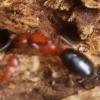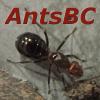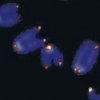- Formiculture.com
- Forums
- Gallery
- Members
- Member Map
- Chat

When do we stop calling them nanitics?
Started By
dominatus
, Aug 20 2019 8:45 PM
9 replies to this topic
#1
 Offline
-
Posted August 20 2019 - 8:45 PM
Offline
-
Posted August 20 2019 - 8:45 PM
Curious, when are the newly eclosing workers no longer considered "nanitics"? My first real founding queen has 8 nanitics. Much smaller then what you usually see for minors but I could see her producing this size of workers for some time.
So when are the new emerging workers just minors and not more nanitics? I would be surprised if there was a real rule to it but wondered what everyone's thoughts were...
So when are the new emerging workers just minors and not more nanitics? I would be surprised if there was a real rule to it but wondered what everyone's thoughts were...
#2
 Offline
-
Posted August 20 2019 - 8:51 PM
Offline
-
Posted August 20 2019 - 8:51 PM
If I recall correctly, the word "nanitics" is only used to describe workers in a queen's first generation/batch of workers.
- VoidElecent and PacificNorthWestern like this
#3
 Offline
-
Posted August 20 2019 - 8:52 PM
Offline
-
Posted August 20 2019 - 8:52 PM
after the first her first batch they are no longer "nanitics". to my knowledge we don't use that term to describe the size of the workers. but rather the first batch of brood that encloses. some more input and information from a more experienced hobbyist may help you understand it better
#4
 Offline
-
Posted August 20 2019 - 9:25 PM
Offline
-
Posted August 20 2019 - 9:25 PM
Curious, when are the newly eclosing workers no longer considered "nanitics"? My first real founding queen has 8 nanitics. Much smaller then what you usually see for minors but I could see her producing this size of workers for some time.
So when are the new emerging workers just minors and not more nanitics? I would be surprised if there was a real rule to it but wondered what everyone's thoughts were...
As stated above Nanitics are the first batch of workers produced by the queen, usually (with fully claustral species) they are fed solely by the queen's saliva/broken down wing muscles. This results in smaller than normal workers. What you are referring to is called Callow Ants which are ants that have recently eclosed from pupae/cocoons and haven't darkened/hardened their exoskeleton yet.
#5
 Offline
-
Posted August 21 2019 - 8:51 AM
Offline
-
Posted August 21 2019 - 8:51 AM
What is the definition of "first batch" then? The queen will continue to lay eggs there is no obvious "batch" of eggs like in bird. For me it should not be nanitics anymore when the worker ants attain the typical worker ant size for the species.
#6
 Offline
-
Posted August 21 2019 - 9:14 AM
Offline
-
Posted August 21 2019 - 9:14 AM
What is the definition of "first batch" then? The queen will continue to lay eggs there is no obvious "batch" of eggs like in bird. For me it should not be nanitics anymore when the worker ants attain the typical worker ant size for the species.
That's not correct.
A queen you collect after nuptial flight won't continuously lay eggs in fact depending on species she will only lay let's say 10-20 eggs and only lay new eggs when there will already be workers when the eggs have developed to larvae so the new workers can then help with taking care of the brood.
So yes there is a first batch of eggs.
- TennesseeAnts likes this
#7
 Offline
-
Posted August 21 2019 - 10:28 AM
Offline
-
Posted August 21 2019 - 10:28 AM
I see one or two more pupae and the rest are larva and eggs of various sizes. After those pupae enclose everything after that would definitely be considered just regular workers?
#8
 Offline
-
Posted August 21 2019 - 11:05 AM
Offline
-
Posted August 21 2019 - 11:05 AM
What is the definition of "first batch" then? The queen will continue to lay eggs there is no obvious "batch" of eggs like in bird. For me it should not be nanitics anymore when the worker ants attain the typical worker ant size for the species.
That's not correct.
A queen you collect after nuptial flight won't continuously lay eggs in fact depending on species she will only lay let's say 10-20 eggs and only lay new eggs when there will already be workers when the eggs have developed to larvae so the new workers can then help with taking care of the brood.
So yes there is a first batch of eggs.
But what if the queen lays eggs when there are still just pupae?
He travels, he seeks the p a r m e s a n.
#9
 Offline
-
Posted August 21 2019 - 11:15 AM
Offline
-
Posted August 21 2019 - 11:15 AM
What is the definition of "first batch" then? The queen will continue to lay eggs there is no obvious "batch" of eggs like in bird. For me it should not be nanitics anymore when the worker ants attain the typical worker ant size for the species.
That's not correct.
A queen you collect after nuptial flight won't continuously lay eggs in fact depending on species she will only lay let's say 10-20 eggs and only lay new eggs when there will already be workers when the eggs have developed to larvae so the new workers can then help with taking care of the brood.
So yes there is a first batch of eggs.
But what if the queen lays eggs when there are still just pupae?
The queen will probably time it so well that there will be workers hatched until the eggs have developed to larvae or shortly after.
#10
 Offline
-
Posted August 21 2019 - 11:36 AM
Offline
-
Posted August 21 2019 - 11:36 AM
There is a study about Camponotus japonicus which suggests that at least in Camponotus species nanitics are a seperate caste with specific physical traits (for example antennae that are far longer compared to their body length than those of regualr workers - this is likely an adaption so that they can properly communicate with larger workers). It's also not necessarily just the first batch, it might be the first two or three batches, depending on the resources the first workers can bring in.
- AntsBC likes this
We should respect all forms of consciousness. The body is just a vessel, a mere hull.
Welcome to Lazy Tube - My Camponotus Journal
1 user(s) are reading this topic
0 members, 1 guests, 0 anonymous users





















